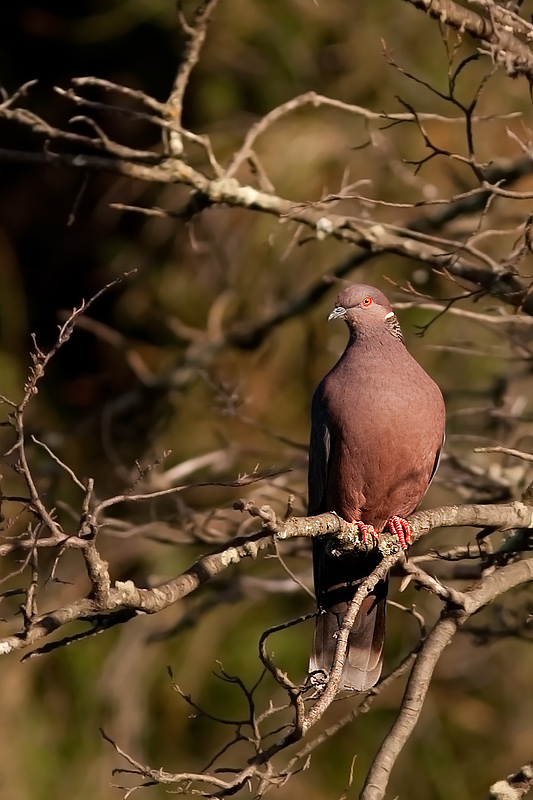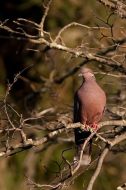Chilean Pigeon
Paloma Araucana
Columba araucana
Length: 370mm. Sexes alike. Bill black; iris orange yellow; head, throat and foreneck vinaceous chestnut, at the union of the nape and the neck it shows a conspicuous white transversal band followed by bronzy with greenish and purplish gloss covering the hind neck; breast, flanks and abdomen vinaceous chestnut; undertail coverts dark vinaceous plumbeous grey. Upper back and scapulars rufous chestnut, lower back and rump dark plumbeous grey; uppertail coverts vinaceous plumbeous grey; rectrices vinaceous plumbeous grey with a broad blackish band halfway. Lesser wing coverts vinaceous chestnut shading to plumbeous grey on the median coverts; greater coverts plumbeous grey with fine whitish margins; proximal secondary remiges plumbeous grey bathed with vinaceous chestnut; distal secondary remiges very dark brown with fine whitish margins; primaries blackish brown, the outermost show a fine whitish margin; underwing coverts and axillaries dark plumbeous grey. Legs crimson red. Juvenile: coloration similar to adults but overall duller and the postnape band is absent as well as the bronzy on the hind neck.
Readily identified by its large size, overall dark colour and white nape band. Habitat and behaviour: it frequents woods, where it is rather difficult to observe, since it roosts in the upper branches, well concealed among the foliage, where it remains very still, well camouflaged in the lights and shadows of the leaves. When it is flushed, it immediately flies away with a characteristic pigeon clapping sound of the wings. It takes off brusquely and its flight is very fast and powerful.
During the breeding season its far-carrying cooing is heard, but the bird is hardly ever seen; it feeds in trees or on the ground, always near woods or inside forests. It feeds on seeds, grains, fruit and acorns. In spring these pigeons gather to eat cherries from plantations and it is odd that they begin to collect them while they are still unripe and entirely green. In winter flocks go to oak trees, where they collect large quantities of acorns.
Chilean Pigeons nest in dense and dark forests, being the pitra and patagua shrubs their preferred breeding sites. The nest is placed midway or low in the tree: a platform made up of carelessly assembled sticks. One or two white eggs are laid. Chicks are born naked and later acquire a yellowish down.
Very common until the early 1950s, when, owing to the devastating effects of a virus contracted from domestic pigeons, its numbers dwindled until it was so rare that in the period between 1960 and 1975 it was feared that it would become extinct.
In 1977, during November, the authors sighted 16 individuals at Lago Puelo in Chubut. Gradually, it was seen more often and by 1987 and 1988 there were large flocks of up to 50 or 60 individuals, both in the vicinity of El Bolsón in Río Negro and near Lago Puelo, at Puerto Patriada, on the margins of the Epuyén lake and at El Hoyo de Epuyén. At present the population has recovered considerably and it can be seen throughout El Bolsón and on the extreme northwest of the province of Chubut. The authors have spotted some ten individuals in a natural Coihue and Cypress wood in the lower part of the Manso River, province of Río Negro. Range: the Chilean Pigeon is limited to the narrow strip of the subantarctic forests from Neuquén to Tierra del Fuego, where it is an occasional visitor. It also occurs in Chile from Aysén to Atacama.
Illustrated Handbook of the Birds of Patagonia
Kindless: Kovacs Family
|









